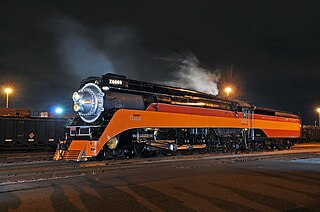
The Southern Pacific was an American Class I railroad network that existed from 1865 to 1996 and operated largely in the Western United States. The system was operated by various companies under the names Southern Pacific Railroad, Southern Pacific Company and Southern Pacific Transportation Company.

The Atchison, Topeka and Santa Fe Railway, often referred to as the Santa Fe or AT&SF, was one of the larger railroads in the United States. The railroad was chartered in February 1859 to serve the cities of Atchison and Topeka, Kansas, and Santa Fe, New Mexico. The railroad reached the Kansas–Colorado border in 1873 and Pueblo, Colorado, in 1876. To create a demand for its services, the railroad set up real estate offices and sold farmland from the land grants that it was awarded by Congress.

The California State Railroad Museum is a museum in the state park system of California, United States, interpreting the role of the "iron horse" in connecting California to the rest of the nation. It is located in Old Sacramento State Historic Park at 111 I Street, Sacramento.

The E7 was a 2,000-horsepower (1,500 kW), A1A-A1A passenger train locomotive built by General Motors' Electro-Motive Division of La Grange, Illinois. 428 cab versions, or E7As, were built from February 1945 to April 1949; 82 booster E7Bs were built from March 1945 to July 1948. The 2,000 hp came from two 12 cylinder model 567A engines. Each engine drove its own electrical generator to power the two traction motors on one truck. The E7 was the eighth model in a line of passenger diesels of similar design known as EMD E-units, and it became the best selling E model upon its introduction.

The EMC E2 was an American passenger-train diesel locomotive which as a single unit developed 1,800 horsepower (1,300 kW), from two (2) 900 horsepower (670 kW) prime movers. These locomotives were typically operated as a unit set or ; where the three unit lashup developed 5400 horsepower. This was almost the ideal horsepower required for the tonnage of a 15 - 18 car passenger train, operated over the ruling grades of virtually all of the mileage between major American cities. The units were of the A1A-A1A wheel arrangement, and manufactured by Electro-Motive Corporation (EMC), later Electro-Motive Diesel (EMD) of La Grange, Illinois.

The Coast Daylight, originally known as the Daylight Limited, was a passenger train on the Southern Pacific Railroad (SP) between Los Angeles and San Francisco, California, via SP's Coast Line. It was advertised as the "most beautiful passenger train in the world," carrying a particular red, orange, and black color scheme. The train operated from 1937 until 1974, one of the few passenger trains retained by Amtrak in 1971. Amtrak merged it with the Coast Starlight in 1974.

Union Pacific 844 is a class "FEF-3" 4-8-4 "Northern" type steam locomotive owned and operated by the Union Pacific Railroad for its heritage fleet. Built in December 1944 by the American Locomotive Company (ALCO) of Schenectady, New York, No. 844 is one of four surviving FEF series locomotives and the only one in operation.

The Southern Pacific GS-4 is a class of streamlined 4-8-4 "Northern" type steam locomotive operated by the Southern Pacific Railroad (SP) from 1941 to 1958. A total of twenty-eight were built by the Lima Locomotive Works, numbered 4430 through 4457. GS stands for "Golden State" or "General Service."

Southern Pacific 4449, also known as the Daylight, is the only surviving example of Southern Pacific Railroad's "GS-4" class of 4-8-4 "Northern" type steam locomotives and one of only two GS-class locomotives surviving, the other being "GS-6" 4460 at the National Museum of Transportation in St. Louis, Missouri. GS is an abbreviation of "General Service" or "Golden State," a nickname for California.

Southern Pacific 4460 is the only surviving class "GS-6" steam locomotive, together with "GS-4" class Southern Pacific 4449, which is operational in excursion service. The GS-6 is a semi-streamlined 4-8-4 "Northern" type steam locomotive. GS stands for "Golden State" or "General Service." The locomotive was built by the Lima Locomotive Works (LLW) for the Southern Pacific Railroad (SP) in 1943. The GS-6 lacked side skirting and red and orange "Daylight" paint found on previous locomotives of the GS class and were painted black and silver instead. The War Production Board controlled locomotive manufacturers during World War II and had turned down Southern Pacific's order of fourteen new Daylight locomotives in 1942. Southern Pacific re-designed the new fleet based on the older GS-2s, only with 260 psi instead of 250 psi, an all-weather cab, and a new GS-4 style tender. The design was finally approved, but the War Production Board reassigned four to the smaller and power-starved Western Pacific Railroad. Their smaller size when compared to previous GS class locomotives and the fact that they were built during World War II earned them the nicknames "War Babies."

Southern Pacific 2479 is one of six 4-6-2 heavy "Pacific" type steam locomotives built by Baldwin Locomotive Works in 1923 for the Southern Pacific Railroad (SP), designated the P-10 class. No. 2479 was retired from service in 1956. The locomotive is currently undergoing restoration to operating condition by the Pacific Locomotive Association at Brightside, California.

Southern Pacific 3100 is a GE U25B diesel-electric locomotive now on permanent exhibit at the Southern California Railway Museum, formerly the Orange Empire Railway Museum in Perris, California, US. It is notable as being the only U25B still in operating condition.
Atchison, Topeka and Santa Fe Railway No. 1010 is a 2-6-2 type steam locomotive built by the Baldwin Locomotive Works in 1901 for Atchison, Topeka and Santa Fe Railway. It started out as a Vauclain compound locomotive before it was rebuilt into a conventional locomotive in the 1910s. It was primarily used for various passenger trains across the Southwestern United States, including the record breaking 1905 Scott Special on the segment between Needles, California, and Seligman, Arizona, before it was reassigned to freight service in the 1940s. It was retired in 1955 and was kept by the Santa Fe for several years for preservation purposes. In 1979, Santa Fe donated No. 1010 to the California State Railroad Museum, where the locomotive resides there in Sacramento as of 2023.

The Lark was an overnight passenger train of the Southern Pacific Company on the 470-mile (760 km) run between San Francisco and Los Angeles. It became a streamliner in 1941 and was discontinued on April 8, 1968. The Lark ran along the same route as the Coast Daylight and was often pulled by a locomotive wearing the famous Daylight paint scheme of orange, red, and black.

The San Joaquin Daylight was a Southern Pacific passenger train inaugurated between Los Angeles and San Francisco's Oakland Pier by way of the San Joaquin Valley and Tehachapi Pass on July 4, 1941. Travel times were between 12 hours (1970) and 14 hours (1944). It operated until the advent of Amtrak in 1971.

The Shasta Daylight was a Southern Pacific Railroad passenger train between Oakland Pier in Oakland, California, and Portland, Oregon. It started on July 10, 1949, and was SP's third "Daylight" streamliner; it had a fast 15-hour-30-minute schedule in either direction for the 713-mile (1,147 km) trip through some of the most beautiful mountain scenery of any train in North America. The Shasta Daylight replaced heavyweight trains on the same route that had taken nearly a day and night to complete the run. The Shasta Daylight was the first diesel powered Daylight and the only Daylight to run beyond California. The scenic route of the Shasta Daylight passed its namesake Mount Shasta in daylight hours.

Southern Pacific 9010 is a KM ML 4000 C'C' diesel-hydraulic locomotive, built in 1964 by German manufacturer Krauss-Maffei for the Southern Pacific Railroad. SP 9010 generated 4,000 horsepower (3,000 kW) from two 2,000-horsepower (1,500 kW) V16 Maybach MD870 diesel engines. It was painted to Southern Pacific's 1958 standard, the so-called "bloody nose" colors of Scarlet and Lark Dark Gray, for its entire operating career. It was renumbered to SP 9113 in late 1965, rebuilt extensively at SP's Sacramento General Shops during the latter half of 1966, and was initially retired in 1968. It was revived and rebuilt by Sacramento General Shops into a "camera car" for the purpose of shooting motion picture background plates for a ground-based full-motion locomotive training simulator. As camera car number 8799, it was retired in 1984 and donated to the California State Railroad Museum in Sacramento, California. It was de-accessioned by CSRM and acquired by the Pacific Locomotive Association and moved to the Niles Canyon Railway's Brightside, California rail yard in the summer of 2008. At the date of its inception, its type represented the highest-horsepower six-axle diesel locomotives in the world. SP 9010 is the sole surviving ML 4000 C'C' built for use in North America, and the sole surviving mainline diesel-hydraulic locomotive in North America.

The Krauss-Maffei ML 4000 is a road switcher diesel-hydraulic locomotive, built between 1961 and 1969 by German manufacturer Krauss-Maffei in Munich, Germany. It generated 3,540 horsepower (2,640 kW) from two Maybach V16 engines. 37 examples were built for two North American railroads and one South American railroad.

Southern Pacific Railroad 2467 is a preserved 4-6-2 “Pacific” type steam locomotive. Built by Baldwin in 1921, it was used by the Southern Pacific Railroad to pull passenger trains until it was retired from service in 1956. On July 25, 1960, it was donated to the city of Oakland, California, who had it placed on display at the Harrison Railroad Park. In July 1990 a restoration began by the Friends of the 2467, which later merged into the Pacific Locomotive Association. In June 1999 it was returned to operation and made an appearance at Railfair 1999. Although serviceable, SP 2467 is currently on static display while on loan from its operator, Pacific Locomotive Association, Inc., to the California State Railroad Museum in Sacramento, California.
The Union Pacific heritage fleet includes commemorative and historic equipment owned by the Union Pacific Railroad. The fleet currently consists of two historic steam locomotives, three historic diesel locomotives, seventeen modern diesel locomotives in historic or commemorative paint schemes and nearly four dozen passenger cars used on office car specials and excursion trains.

















